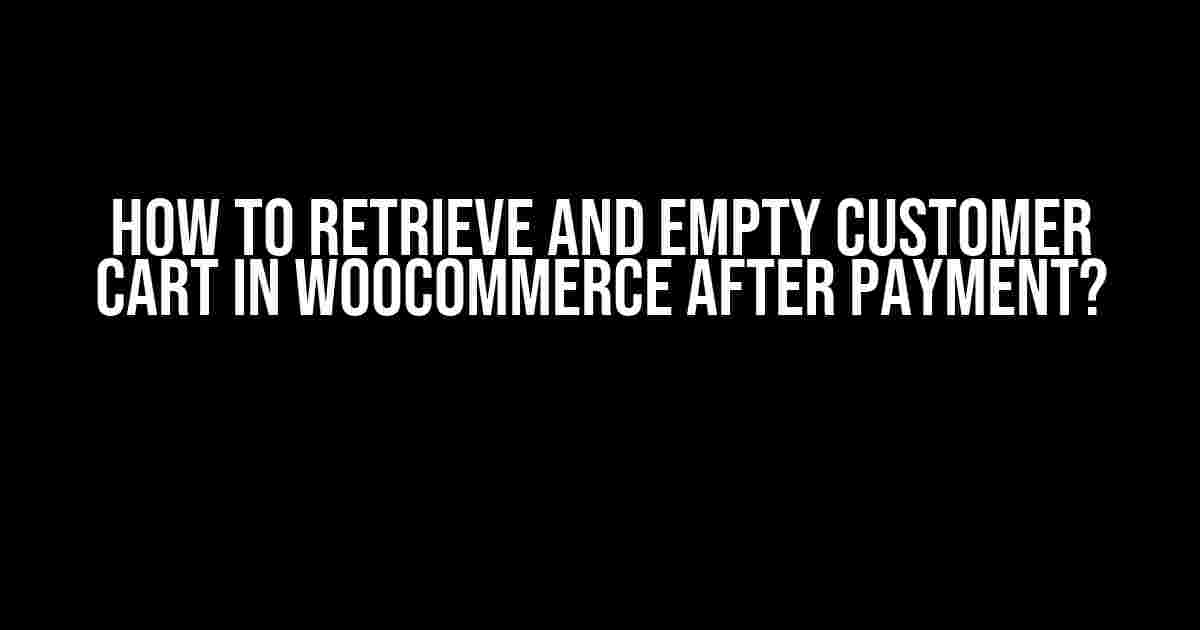In this article, we’ll guide you through the process of retrieving and emptying a customer’s cart in WooCommerce after payment. This is an essential step in providing a seamless shopping experience for your customers, as it helps to prevent duplicate orders and ensures that your inventory levels are up-to-date.
Why You Need to Retrieve and Empty Customer Cart?
When a customer places an order on your WooCommerce site, the products they’ve added to their cart remain there until they complete the payment process. If the customer doesn’t complete the payment, those products will still be reserved in their cart, which can lead to:
- Inventory discrepancies
- Duplicate orders
- Confusion for the customer
- And ultimately, a poor shopping experience
By retrieving and emptying the customer’s cart after payment, you can ensure that your inventory levels are accurate, and the customer’s cart is ready for their next purchase.
Step 1: Understanding WooCommerce Hooks
Before we dive into the coding part, it’s essential to understand WooCommerce hooks. Hooks are a way to modify or extend WooCommerce functionality without modifying the core code. There are two types of hooks:
- Actions: Allow you to execute a function at a specific point in the code
- Filters: Allow you to modify data at a specific point in the code
In this tutorial, we’ll use the `woocommerce_payment_complete` action hook to execute our code after the payment is complete.
Step 2: Writing the Code
Create a new file in your theme’s directory, for example, `empty-cart-after-payment.php`, and add the following code:
<?php
function empty_cart_after_payment($order_id) {
// Get the current user's cart
$cart = WC()->cart;
// Empty the cart
$cart->empty_cart();
}
add_action('woocommerce_payment_complete', 'empty_cart_after_payment');
?>
This code uses the `woocommerce_payment_complete` action hook to trigger the `empty_cart_after_payment` function after the payment is complete. The function retrieves the current user’s cart using `WC()->cart` and then empties it using `$cart->empty_cart()`.
Step 3: Integrating the Code with Your Theme
To integrate the code with your theme, add the following line to your theme’s `functions.php` file:
require_once(get_template_directory() . '/empty-cart-after-payment.php');
This line includes the `empty-cart-after-payment.php` file in your theme’s `functions.php` file, making the code available to your site.
Step 4: Testing the Code
To test the code, follow these steps:
- Place an order on your WooCommerce site as a customer
- Complete the payment process
- Check your cart
- The cart should be empty
If the cart is empty, congratulations! You’ve successfully implemented the code to retrieve and empty the customer’s cart after payment.
Troubleshooting Common Issues
Here are some common issues you might encounter and their solutions:
| Issue | Solution |
|---|---|
| The cart is not emptying after payment | Check if the `woocommerce_payment_complete` action hook is firing correctly. You can do this by adding a `die()` statement in the `empty_cart_after_payment` function. |
| The cart is emptying before payment is complete | Check if you’ve added the code to the correct hook. Make sure you’re using the `woocommerce_payment_complete` action hook and not another hook. |
| The code is not working in my custom theme | Check if your theme is correctly including the `empty-cart-after-payment.php` file. Make sure the file is in the correct directory, and the `require_once` statement is correct. |
Conclusion
Retrieving and emptying the customer’s cart after payment is a crucial step in providing a seamless shopping experience on your WooCommerce site. By following the steps outlined in this article, you can ensure that your inventory levels are accurate, and your customers’ carts are ready for their next purchase.
Remember to test the code thoroughly to ensure it’s working correctly on your site. If you encounter any issues, refer to the troubleshooting section or seek help from a developer.
That’s it! By implementing this code, you’ll be able to retrieve and empty customer carts after payment, ensuring a smoother shopping experience for your customers.
Here are 5 Questions and Answers about “How to retrieve and empty customer cart in WooCommerce after payment?” :
Frequently Asked Question
Get the inside scoop on how to retrieve and empty customer cart in WooCommerce after payment!
What is the purpose of retrieving and emptying the customer cart after payment in WooCommerce?
Retrieving and emptying the customer cart after payment in WooCommerce ensures that the customer’s cart is updated in real-time, providing an accurate representation of their recent purchases. This also helps prevent duplicate orders and reduces cart abandonment rates.
How do I retrieve the customer’s cart contents in WooCommerce after payment?
You can retrieve the customer’s cart contents using the `WC()->cart` object. Specifically, you can use the `WC()->cart->get_cart_contents()` method to retrieve an array of cart items.
How do I empty the customer’s cart in WooCommerce after payment?
To empty the customer’s cart, you can use the `WC()->cart->empty_cart()` method. This will remove all items from the cart and update the cart totals.
Is there a WooCommerce hook that I can use to retrieve and empty the customer cart after payment?
Yes, you can use the `woocommerce_payment_complete` action hook to retrieve and empty the customer cart after payment. This hook is triggered after the payment has been processed and the order has been marked as completed.
What are some potential issues I should be aware of when retrieving and emptying the customer cart in WooCommerce after payment?
Be aware of potential issues such as cart session timeouts, multiple payment gateways, and custom cart implementations that may affect the retrieval and emptying of the customer cart. Additionally, ensure that you’re testing your implementation thoroughly to avoid any unexpected behavior.
